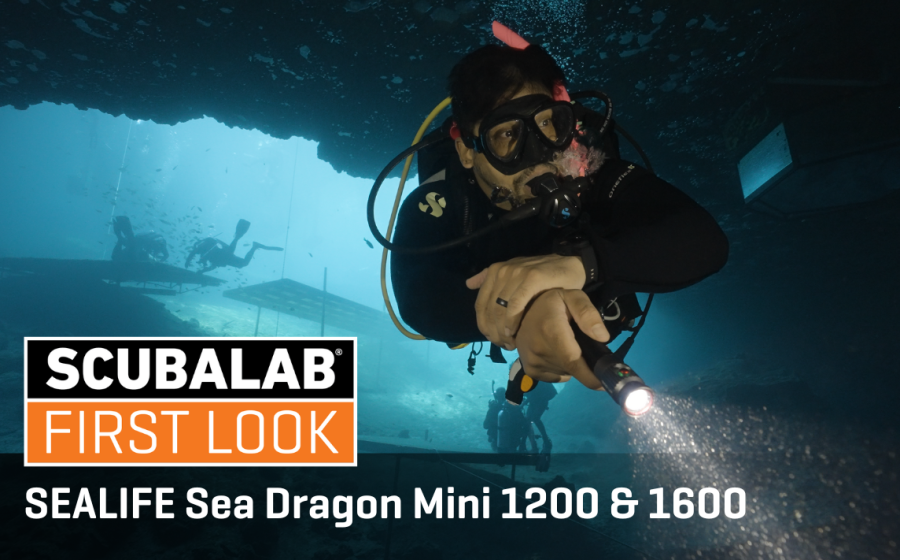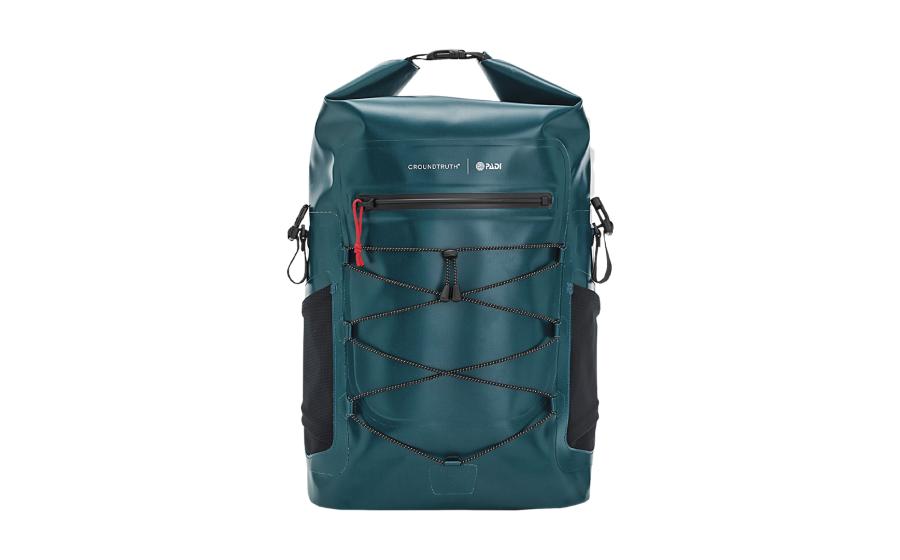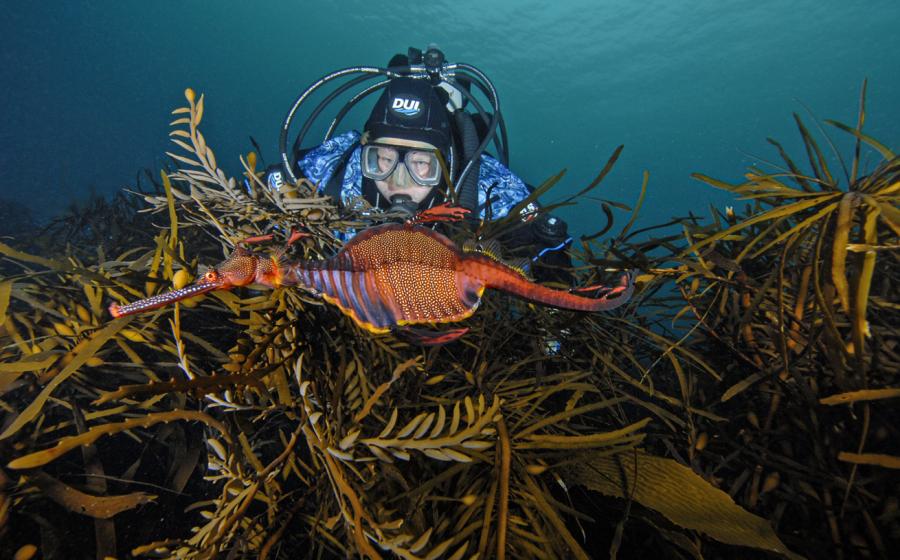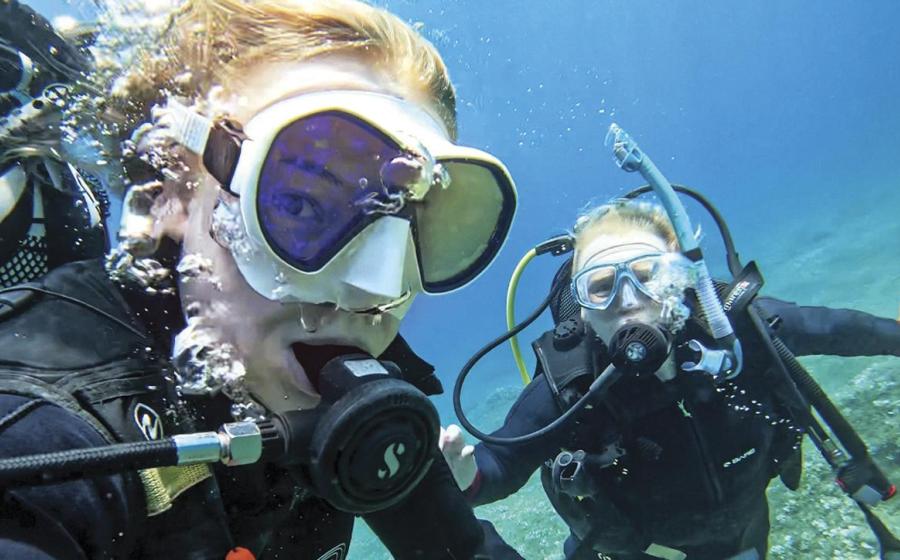The Art of Fish Photography
||
|---|
|  |
|
There is a great deal about photographing reef creatures that involves technical minutiae. F-stops, strobe power, focus, direction of light, color temperature, film choice, and simply the task of keeping the water on the outside of the O-ring are all technical challenges.
Yet there is another, more abstract element to successful fish photography that is equally important: observing and learning fish behaviors, then predicting the reactions to the photographer's presence. In short: Be one with the fish, Grasshopper.
Size: Right Subject, Right Lens
This axiom involves not only the size of the creature you hope to photograph, but also its tolerance to intrusion. Give careful consideration to both when choosing your subject.
The universe for fish photography with a Nikonos, Reefmaster, or Sea & Sea 35mm is between 2.5 and 6 feet. Maximum distance is limited because it's nearly impossible to get good color and resolution beyond about 6 feet. Minimum distance is determined by the lens's minimum focus. Any subject that can't properly fill the frame within these distance parameters should be ignored (photographically anyway).
There are add-on optics for these cameras that can enhance close-focus capability. Or if you are working with a macro lens on a housed camera, your range would be from within a few inches in front of the lens port to 6 feet. Zoom lenses in a housed camera will also expand the size universe of creatures you might choose to photograph.
But the point is, whichever lens or supplementary optic is used will define the viable subjects. Know your optical tools, their capabilities and their limitations.
Tolerance: Another Limit
There may be subjects of reasonable size that simply won't tolerate the photographer's proximity. For example, I have seen pictures of yellowhead jawfish taken with 1:2 extension tubes. But it required a patient photographer, a bold jawfish and some luck because macro framers normally scare the fish back into its burrow. In this case, a housed camera with a 105mm macro lens is the better tool. The extension tube shooter will be more successful finding subjects that allow the intrusion of the framer, perhaps a scorpionfish or an invertebrate. You must accept that some critters simply aren't appropriate for your system.
Fish Behaviors: Learn Them
||
|---|
|  |
|
A degree in marine biology isn't necessary to become a good fish photographer, but it is interesting to note how many top fish shooters have a background in marine science. Is it because they were predisposed to have an interest in fish behavior in pursuing their education, or did their education provide uncommon insight into how fishes are likely to behave? Probably some of each.
Insight into why a fish might be inclined to stay in the area, whether to be cleaned, to mate or to eat, will give the photographer enhanced access to skittish creatures. Observation can also help you predict what may happen next. With prediction comes preparation. The prepared shooter can then react to what may be a fleeting, yet productive encounter.
Habitat: Live It
The skilled fish photographer will know what kinds of habitat are likely to provide refuge for particular kinds of critters. Seemingly featureless reef rubble may be wonderfully productive for gobies and shrimp. Within the knurled polyps of a sea fan may lurk a minuscule pygmy seahorse. A bit of broken sponge might be a smorgasbord for a normally reclusive queen angelfish. A violet egg mass might signal an opportunity to shoot a sergeant major defending its progeny against a bold, predatory hawkfish. A reef ledge might be a good place to find nocturnal fish like bigeyes, or perhaps a turtle or nurse shark at rest.
Knowledge of fish habitat is a corollary of understanding fish behavior, but mastery of both will present a much higher percentage of interesting encounters.
Preparation: The Art of Previsualization
||
|---|
|  |
|
Previsualization comes with experience. It is the skill to see in the mind's eye what the photograph could be, assuming the synchronicity of approach, behavior, technical preparation and execution. This is the intimacy of the artist with the medium. This is the ability to look at the reef scene from afar and know what it will look like through the 28mm lens from 2 feet away. This is the ability to predict what the depth of field might be at f-22 when photographing the head of a crocodilefish from a specific angle. This is knowing what the color palette of Velvia might be in combination with the color temperature of a Nikonos SB-104 strobe, and why this might be better for wide-angle than macro applications. And it means imagining not only the primary subject, but also the entire composition in a best-case scenario, and then making it happen.
Shoot Zone: Defining It
The shoot zone is that magic area between the lens's minimum focus and 6 feet, subdivided into the distance that allows ideal composition of the subject given the optic in use, modified by the subject's field of fright. Sound complicated? Actually all it means is that beyond 6 feet you won't have good color, and if you get too close the fish might swim off. So, you have to get close enough to get the composition you've previsualized. That's the shoot zone.
However, once you enter the shoot zone, things can happen quickly. You may get only a couple of shots before the fish swims away. Be ready to react. This is not the time to be clearing your mask, aiming strobes or fiddling with f-stops. Before you enter the shoot zone, predict how close you'd like to be and choose the appropriate f-stop. Aim the strobes accordingly. Make sure the strobes are fully recycled. Control your breathing so that exhaust bubbles are at a minimum. Move in to the shoot zone in complete control of yourself and your photo equipment.
Shoot Zone: Mastering It
||
|---|
|  |
|
Once you've entered the shoot zone, you have to make the photo happen before the fish swims off. With some fish, you know you'll have plenty of time. A stonefish might be extremely tolerant of a diver's proximity and strobes, so there's no reason you couldn't shoot a combination of verticals and horizontals, with various compositions. When you're done, the fish will likely be unperturbed, resting in the same position in which you found it. On the other hand, with garden eels, sometimes it seems simply looking in their direction is enough to drive them back into the sand.
Most fish are somewhere in between in terms of their photo-avoidance behavior, but a strobe that recycles quickly and intuitive photo technique will enhance shoot zone performance. Know what f-stop brackets are appropriate according to distance and subject reflectance. And constantly re-evaluate your previsualization according to the scene that unfolds.
Respect: The Fish Know
Sometimes it seems that fish photography is adversarial. The fish have something we want (their images), and even though we may mean them no harm, our very presence is intrusive. If they are hunting, we'll likely scare off their prey and, more likely, the fish will assume this giant bubble-belching alien is a predator they should avoid. Fish photographers have to work toward communicating a benign presence.
Some things that have worked for me in the past include a slow, gentle approach, minimal eye contact during shoot zone preparation, and control of exhaust bubbles as much as possible inside the shoot zone. But there is something else as well. I believe a fish can sense aggression or evil intent. I believe the best fish photographers are those who absolutely revere their subjects.
Somehow, the fish know.
Mastering the Shoot Zone
||
|---|
|  |
|
Before you get in the zone:
-
Observe the animal's behavior pattern
-
Visualize the shot
-
Preset strobes and f-stop
-
Calculate the animal's distance tolerance
After you get in the zone:
-
Approach slowly and gently
-
Avoid eye contact
-
Control exhaust bubbles
-
Revisualize the shot as necessary
|| |---|
| |
There is a great deal about photographing reef creatures that involves technical minutiae. F-stops, strobe power, focus, direction of light, color temperature, film choice, and simply the task of keeping the water on the outside of the O-ring are all technical challenges.
|
There is a great deal about photographing reef creatures that involves technical minutiae. F-stops, strobe power, focus, direction of light, color temperature, film choice, and simply the task of keeping the water on the outside of the O-ring are all technical challenges.
Yet there is another, more abstract element to successful fish photography that is equally important: observing and learning fish behaviors, then predicting the reactions to the photographer's presence. In short: Be one with the fish, Grasshopper.
Size: Right Subject, Right Lens
This axiom involves not only the size of the creature you hope to photograph, but also its tolerance to intrusion. Give careful consideration to both when choosing your subject.
The universe for fish photography with a Nikonos, Reefmaster, or Sea & Sea 35mm is between 2.5 and 6 feet. Maximum distance is limited because it's nearly impossible to get good color and resolution beyond about 6 feet. Minimum distance is determined by the lens's minimum focus. Any subject that can't properly fill the frame within these distance parameters should be ignored (photographically anyway).
There are add-on optics for these cameras that can enhance close-focus capability. Or if you are working with a macro lens on a housed camera, your range would be from within a few inches in front of the lens port to 6 feet. Zoom lenses in a housed camera will also expand the size universe of creatures you might choose to photograph.
But the point is, whichever lens or supplementary optic is used will define the viable subjects. Know your optical tools, their capabilities and their limitations.
Tolerance: Another Limit
There may be subjects of reasonable size that simply won't tolerate the photographer's proximity. For example, I have seen pictures of yellowhead jawfish taken with 1:2 extension tubes. But it required a patient photographer, a bold jawfish and some luck because macro framers normally scare the fish back into its burrow. In this case, a housed camera with a 105mm macro lens is the better tool. The extension tube shooter will be more successful finding subjects that allow the intrusion of the framer, perhaps a scorpionfish or an invertebrate. You must accept that some critters simply aren't appropriate for your system.
Fish Behaviors: Learn Them
|| |---|
| |
A degree in marine biology isn't necessary to become a good fish photographer, but it is interesting to note how many top fish shooters have a background in marine science. Is it because they were predisposed to have an interest in fish behavior in pursuing their education, or did their education provide uncommon insight into how fishes are likely to behave? Probably some of each.
|
A degree in marine biology isn't necessary to become a good fish photographer, but it is interesting to note how many top fish shooters have a background in marine science. Is it because they were predisposed to have an interest in fish behavior in pursuing their education, or did their education provide uncommon insight into how fishes are likely to behave? Probably some of each.
Insight into why a fish might be inclined to stay in the area, whether to be cleaned, to mate or to eat, will give the photographer enhanced access to skittish creatures. Observation can also help you predict what may happen next. With prediction comes preparation. The prepared shooter can then react to what may be a fleeting, yet productive encounter.
Habitat: Live It
The skilled fish photographer will know what kinds of habitat are likely to provide refuge for particular kinds of critters. Seemingly featureless reef rubble may be wonderfully productive for gobies and shrimp. Within the knurled polyps of a sea fan may lurk a minuscule pygmy seahorse. A bit of broken sponge might be a smorgasbord for a normally reclusive queen angelfish. A violet egg mass might signal an opportunity to shoot a sergeant major defending its progeny against a bold, predatory hawkfish. A reef ledge might be a good place to find nocturnal fish like bigeyes, or perhaps a turtle or nurse shark at rest.
Knowledge of fish habitat is a corollary of understanding fish behavior, but mastery of both will present a much higher percentage of interesting encounters.
Preparation: The Art of Previsualization
|| |---|
| |
Previsualization comes with experience. It is the skill to see in the mind's eye what the photograph could be, assuming the synchronicity of approach, behavior, technical preparation and execution. This is the intimacy of the artist with the medium. This is the ability to look at the reef scene from afar and know what it will look like through the 28mm lens from 2 feet away. This is the ability to predict what the depth of field might be at f-22 when photographing the head of a crocodilefish from a specific angle. This is knowing what the color palette of Velvia might be in combination with the color temperature of a Nikonos SB-104 strobe, and why this might be better for wide-angle than macro applications. And it means imagining not only the primary subject, but also the entire composition in a best-case scenario, and then making it happen.
|
Previsualization comes with experience. It is the skill to see in the mind's eye what the photograph could be, assuming the synchronicity of approach, behavior, technical preparation and execution. This is the intimacy of the artist with the medium. This is the ability to look at the reef scene from afar and know what it will look like through the 28mm lens from 2 feet away. This is the ability to predict what the depth of field might be at f-22 when photographing the head of a crocodilefish from a specific angle. This is knowing what the color palette of Velvia might be in combination with the color temperature of a Nikonos SB-104 strobe, and why this might be better for wide-angle than macro applications. And it means imagining not only the primary subject, but also the entire composition in a best-case scenario, and then making it happen.
Shoot Zone: Defining It
The shoot zone is that magic area between the lens's minimum focus and 6 feet, subdivided into the distance that allows ideal composition of the subject given the optic in use, modified by the subject's field of fright. Sound complicated? Actually all it means is that beyond 6 feet you won't have good color, and if you get too close the fish might swim off. So, you have to get close enough to get the composition you've previsualized. That's the shoot zone.
However, once you enter the shoot zone, things can happen quickly. You may get only a couple of shots before the fish swims away. Be ready to react. This is not the time to be clearing your mask, aiming strobes or fiddling with f-stops. Before you enter the shoot zone, predict how close you'd like to be and choose the appropriate f-stop. Aim the strobes accordingly. Make sure the strobes are fully recycled. Control your breathing so that exhaust bubbles are at a minimum. Move in to the shoot zone in complete control of yourself and your photo equipment.
Shoot Zone: Mastering It
|| |---|
| |
Once you've entered the shoot zone, you have to make the photo happen before the fish swims off. With some fish, you know you'll have plenty of time. A stonefish might be extremely tolerant of a diver's proximity and strobes, so there's no reason you couldn't shoot a combination of verticals and horizontals, with various compositions. When you're done, the fish will likely be unperturbed, resting in the same position in which you found it. On the other hand, with garden eels, sometimes it seems simply looking in their direction is enough to drive them back into the sand.
|
Once you've entered the shoot zone, you have to make the photo happen before the fish swims off. With some fish, you know you'll have plenty of time. A stonefish might be extremely tolerant of a diver's proximity and strobes, so there's no reason you couldn't shoot a combination of verticals and horizontals, with various compositions. When you're done, the fish will likely be unperturbed, resting in the same position in which you found it. On the other hand, with garden eels, sometimes it seems simply looking in their direction is enough to drive them back into the sand.
Most fish are somewhere in between in terms of their photo-avoidance behavior, but a strobe that recycles quickly and intuitive photo technique will enhance shoot zone performance. Know what f-stop brackets are appropriate according to distance and subject reflectance. And constantly re-evaluate your previsualization according to the scene that unfolds.
Respect: The Fish Know
Sometimes it seems that fish photography is adversarial. The fish have something we want (their images), and even though we may mean them no harm, our very presence is intrusive. If they are hunting, we'll likely scare off their prey and, more likely, the fish will assume this giant bubble-belching alien is a predator they should avoid. Fish photographers have to work toward communicating a benign presence.
Some things that have worked for me in the past include a slow, gentle approach, minimal eye contact during shoot zone preparation, and control of exhaust bubbles as much as possible inside the shoot zone. But there is something else as well. I believe a fish can sense aggression or evil intent. I believe the best fish photographers are those who absolutely revere their subjects.
Somehow, the fish know.
Mastering the Shoot Zone
|| |---|
| |
Before you get in the zone:
|
Before you get in the zone:
Observe the animal's behavior pattern
Visualize the shot
Preset strobes and f-stop
Calculate the animal's distance tolerance
After you get in the zone:
Approach slowly and gently
Avoid eye contact
Control exhaust bubbles
Revisualize the shot as necessary






